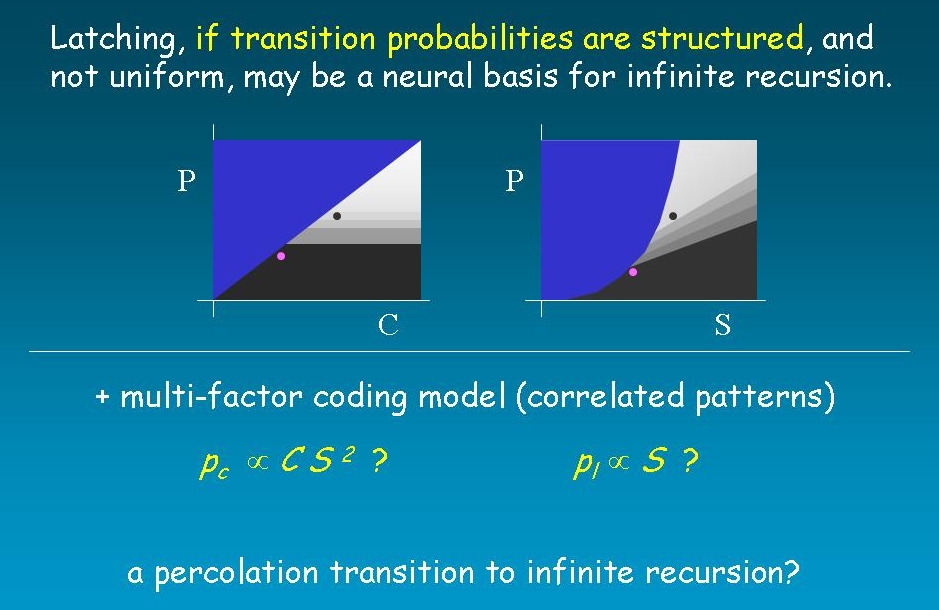 Understanding
the neural basis of higher
cognitive functions, such as those involved in language, in
planning,
in logics,
requires as a very prerequisite a shift from mere localization,
which
has been
popular with imaging research, to an analysis of network
operation. A
recent
proposal (Hauser, Chomsky & Fitch, Science, 2002)
points at infinite recursion as the core of several
higher functions, and thus challenges cortical network theorists
to
describe network
behavior that could subserve infinite
recursion.
Considering a class of reduced Potts models (Kanter,
PRL, 1988) of large semantic associative networks [1,2], their
storage
capacity
has been studied analytically with statistical physics methods
[3,4],
and their dynamics simulated, once the units are endowed with a
simple
model of
firing frequency adaptation. Such models naturally display
latching
dynamics,
i.e. they hop from one attractor to the next following a
stochastic
process
based on the correlations among attractors. The proposal is that
such
latching
dynamics may be associated with a network capacity for infinite
recursion, in
particular because it turns out, from the simulations and from
analytical
arguments [3], that latching only occurs after a percolation
phase transition, once
the network
connectivity becomes sufficiently extensive to support structured
transition
probabilities between global network states (work in progress by
ER, AT). The crucial development
endowing a
semantic system with a non-random dynamics would thus be an
increase in
connectivity, perhaps to be identified with the dramatic increase
in
spine
numbers recently observed in the basal dendrites of pyramidal
cells in
Understanding
the neural basis of higher
cognitive functions, such as those involved in language, in
planning,
in logics,
requires as a very prerequisite a shift from mere localization,
which
has been
popular with imaging research, to an analysis of network
operation. A
recent
proposal (Hauser, Chomsky & Fitch, Science, 2002)
points at infinite recursion as the core of several
higher functions, and thus challenges cortical network theorists
to
describe network
behavior that could subserve infinite
recursion.
Considering a class of reduced Potts models (Kanter,
PRL, 1988) of large semantic associative networks [1,2], their
storage
capacity
has been studied analytically with statistical physics methods
[3,4],
and their dynamics simulated, once the units are endowed with a
simple
model of
firing frequency adaptation. Such models naturally display
latching
dynamics,
i.e. they hop from one attractor to the next following a
stochastic
process
based on the correlations among attractors. The proposal is that
such
latching
dynamics may be associated with a network capacity for infinite
recursion, in
particular because it turns out, from the simulations and from
analytical
arguments [3], that latching only occurs after a percolation
phase transition, once
the network
connectivity becomes sufficiently extensive to support structured
transition
probabilities between global network states (work in progress by
ER, AT). The crucial development
endowing a
semantic system with a non-random dynamics would thus be an
increase in
connectivity, perhaps to be identified with the dramatic increase
in
spine
numbers recently observed in the basal dendrites of pyramidal
cells in In
a collaboration
with Susan Rothstein at
In parallel, we are conducting psychophysical experiments that closely model those by Onnis et al (2003), on the influence of variability in the statistical learning of correlations (NvR & AG).